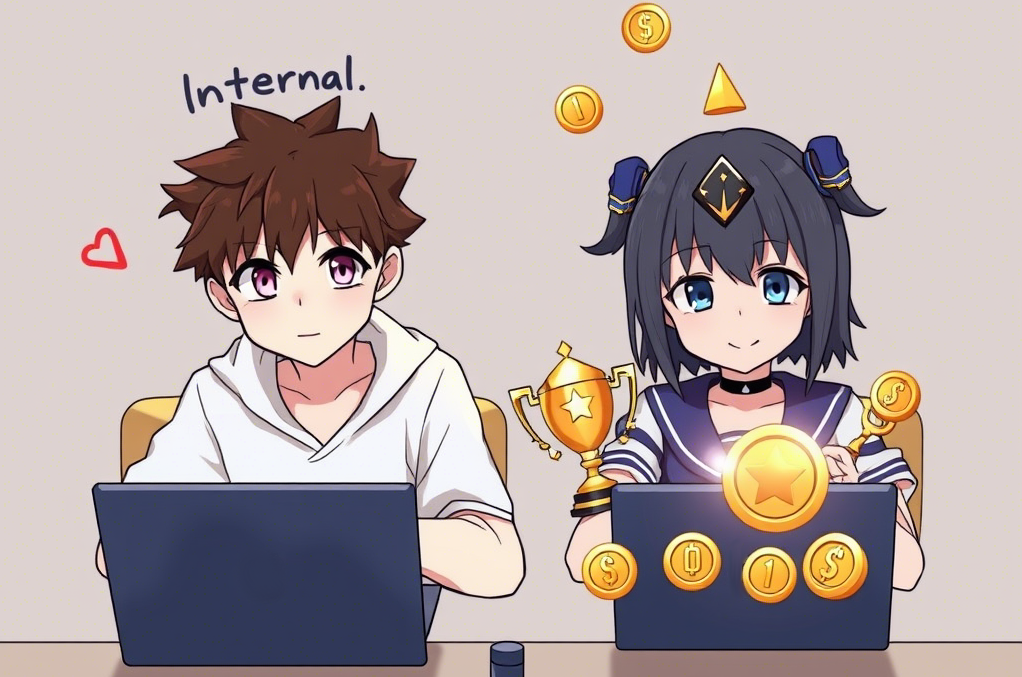Motivation in Games
Motivation plays a critical role in human behavior, influencing how we engage with activities and derive satisfaction.
In gaming, motivation determines why players choose to play.

However, many modern games focus too much on extrinsic motivation and struggle with retention. We often forget how important intrinsic motivation is in game design!
What Are Intrinsic & Extrinsic Motivation?

In short:
- Extrinsic motivation is doing something for a reward.
- Intrinsic motivation is doing something because you enjoy it.

This statement simplifies the concept, but it’s the easiest way to understand it!
Let’s explore this further
How Can We Identify Extrinsic Motivation in Games?
A simple way to spot extrinsic motivation in games is to check whether a feature is not directly part of the gameplay but still encourages the player to play.
For example, you’ve probably seen leaderboards, achievements, or monetary rewards in mobile games. These mechanics encourage play, but they aren’t part of the core gameplay experience.
Similarly, daily quests and login rewards often push players to complete tasks not because they enjoy them but to unlock a new skin or bonus. This is a clear example of extrinsic motivation in action.
Is It Bad to Use Extrinsic Motivation in Game Design?
Not at all! Extrinsic motivators can be useful, but they should only supplement the gameplay experience. Players shouldn’t play a game just to top the leaderboard or unlock a cosmetic item.
While extrinsic rewards can boost short-term engagement, they can also backfire and weaken the very motivation that made the game fun in the first place.
There are positive ways to use extrinsic motivation, but that’s a topic for another article!
How Can We Identify Intrinsic Motivation in Games?
A great example of intrinsic motivation is found in open-world exploration games like:
- The Legend of zelda
- Grand Theft Auto V
- Death Stranding
- Elden Ring
In these games, players spend hours exploring because they want to, not because of leaderboards or daily rewards. The motivation comes from within the gameplay itself and the player’s own curiosity.
How Can Game Designers Foster Intrinsic Motivation?
To answer this, let’s talk about some basic human psychology.
Self-Determination Theory (SDT)
The famous Self-Determination Theory (SDT) by Edward Deci and Richard Ryan states that people are most motivated when they experience:
- Autonomy (freedom to make meaningful choices)
- Competence (a sense of mastery and improvement)
- Relatedness (connection to others and meaningful engagement)
Games that focus on these three principles naturally foster intrinsic motivation.
Let’s Break This Down:
- Autonomy:
– The ability to make meaningful choices and play the game in your own way.
– Example: Minecraft thrives on this principle, letting players set their own objectives. - Competence:
– A sense of mastery or improvement—learning skills to progress.
– Example: Dark Souls motivates players to persist despite failure because they can see their progress. - Relatedness & Purpose:
– Feeling connected to other players or the game world, and having a purpose beyond rewards.
– Example: Animal Crossing builds engagement through relationships with villagers and friends.
If you want to dive deeper into this topic, I recommend the book “Drive” by Daniel H. Pink!
Why Should Game Designers Focus on Intrinsic Motivation?
These days, many games rely too much on extrinsic motivation—daily rewards, loot boxes, ranking systems—but these mechanics often lead to:
- Burnout
- Frustration
- Disengagement once the rewards lose their appeal
We can understand it better with
The Famous Old Man Story

An old man lived in a neighborhood where children frequently played outside his house, making a lot of noise. Frustrated but aware that scolding them wouldn’t work, he devised a clever plan. One day, he offered each child a small sum of money to continue playing outside his house, saying he enjoyed their noise. The kids, delighted by this unexpected reward, returned every day. Over time, the man reduced the payment until he eventually stopped giving them money altogether. Disappointed and feeling that their play was now “work,” the kids lost interest and stopped coming entirely.
This story highlights the danger of extrinsic rewards—they can turn a fun, self-motivated activity into something that feels like work, killing the original enjoyment.
Applying This to Games
Imagine a player who naturally enjoys exploring a game world.
If the game suddenly starts rewarding XP or currency for discoveries, the player’s focus shifts from enjoying exploration to grinding for rewards.
When those rewards disappear, the player may lose all motivation to explore—even though they originally loved it.
When those rewards disappear, the player may lose all motivation to explore—even though they originally loved it.
Focusing on intrinsic motivation helps create deeper, more meaningful experiences that keep players engaged for the right reasons—because they genuinely love playing.